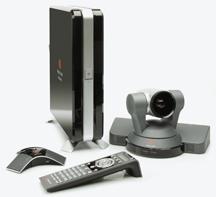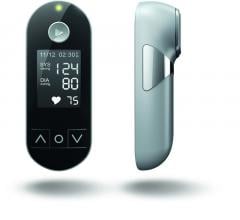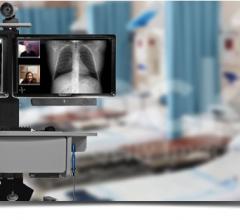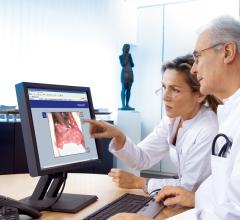
Dr. Catherine Webb is the director of telecardiology at Childrens Memorial Hospital in Chicago, which started its program in 1993 and today handles up to 1,500 cases a year.
Congenital heart disease contributes to more than 30 percent of infant mortality in the U.S., so time is essential in diagnosing and treating these conditions in newborns. However, most hospitals do not have pediatric cardiac specialists on staff who can diagnose and suggest courses of treatment, which is why telecardiology has bloomed in this field. In recent years numerous hospital telemedicine networks have been created for the sole purpose of aiding diagnosis of pediatric congenital heart disease.
Catherine L. Webb, M.D., director of telecardiology and attending cardiologist at Children's Memorial Hospital (CMH) in Chicago, and professor of pediatric medicine at the Feinburg School of Medicine at Northwestern University, said CMH has been operating a pediatric cardiology telemedicine system since 1993. It includes 10 hospitals in the Chicago metropolitan area. The system has grown from 20-30 transmissions per year when it started, to between 1,200 and 1,500 consultations a year now. Dr. Webb said these cases make up about 20 percent of the case volume for the pediatric structural heart specialists at CMH.
“It's for any suspected cases of congenital heart diseases,” Dr. Webb said. “Congenital heart disease in the neonatal period can be very serious. It is a deadly disease.”
CMH acts as a hub facility, supplying its staff of expert pediatric congenital heart specialists. The remote hospitals, located in Chicago and the surrounding collar counties, can call into the system and request a transmission where ultrasound images are sent live so a specialist can determine if there is an issue. Some of the hospitals in the network have very good cardiac departments, however they only specialize in adult medicine.
“Its basically a video conferencing system,” Dr. Webb said. “It's really quite inexpensive.”
The cost of initial installation ISDN lines and conferencing equipment at the satellite hospitals has varied from $2,000 to $25,000 and has been dependent on the complexity of the installation issues, Dr. Webb said. She said the system components are available off the shelf from teleconferencing system companies. CMH’s desktop PC system with appropriate hardware and software for the videoconferencing system cost about $10,000 to implement, she said.
It uses a video camera mounted on a computer at both CMH and at the remote site hospital. The remote hospitals modify their ultrasound machines with a jack so it can be plugged into the video conferencing system. The sonographer can then toggle between images from the ultrasound machine and the consulting doctor. The system uses a integrated services digital network ISDN phone line connection that can transmit at a speed of about 384 kilobytes per second, which Dr. Webb said is adequate to get ultrasound images good enough to make a diagnosis.
“We can interact directly with the technician as they are doing the study so we can see it in real time,” Dr. Webb said.
Many ultrasound technicians are trained for adult cardiac exams, but they are not familiar with what to look for in neonates. For that reason the specialists often help direct the study and explain how and where to place the transducer.
“We [the specialists] are expensive, so if they can have a video link to us it is more cost effective for the hospital and more efficient for our time,” Dr. Webb said. “With the telemedicine system the time to diagnosis is reduced, treatment and transport for the infants with serious congenital heart disease can be implemented sooner and the cost to transport patients who do not have heart disease is eliminated.”
Prior to the telecardiology system, she said doctors from CMH would have to drop what they were doing and drive across the city to see patients, or have the patients transferred — both of which are time consuming and expensive.
CMH is now working to convert its phone-based system to a Web-based system so it can better interface with DICOM images and the patient's electronic medical record (EMR). Currently this link with EMRs is missing and hospitals rely on faxing copies of the patients' insurance and medical information to CMH. However, HIPAA compliance and privacy and security firewall issues at the various hospitals have caused difficulties in getting the system operational, Dr. Webb said.
Charges for the transmitted echocardiogram are negotiated individually with each remote hospital. Dr. Webb said some sites charge the patient a hospital charge for the echocardiogram and CMH then bills the patient separately for the professional interpretation fee. Other sites prefer to pay a flat annual fee to CMH for telemedicine services, while billing the patient directly.
Dr. Webb was in consultation with David J. Sahn, M.D., professor of pediatrics, obstetrics and gynecology, and radiology at Oregon Health Sciences University (OHSU) in Portland, OR, in a multicenter pediatric telemedicine trial in 1999 through 2000. They led 24 pediatric cardiology centers throughout the U.S. in an 18-month investigation comparing medical and financial outcomes of telecardiology and traditional methods of cardiac care delivery for neonates with suspected congenital heart disease. The study helped validate telecardiology systems.
Dr. Sahn has gone on to help the U.S. military create the Department of Defense Neonatal Telemedicine Echocardiography Program, which is managed by him and other investigators at OHSU and Madigan Army Medical Center. The program is designed to assess neonatal heart disease in babies at remote military or native American healthcare facilities in Washington, California and Alaska. The program uses SonoSite hand-held ultrasound devices and video teleconferencing equipment. Instead of using outside vendors, an existing military version of Internet2, NIPRNET (Non-Secret IP Router Network) was used, which provides up to 712 kpbs of bandwidth and improved visualization of the cardiac images.
Setting up a Telemedicine Program
Teleconferencing device company Polycom Inc. helps hospitals connect their PACS, EMRs and teleconferencing into telemedicine networks. The company has helped establish both telecardiology networks and telestroke networks.
“We have a shortage of healthcare specialists and they are mainly located in urban areas,” said Ron Emerson, RN, BSN, Polycom’s global director of healthcare, “In addition to this shortage, medical knowledge is rapidly growing and telemedicine provides a way to bring state-of-the-art medicine to distant medical centers. We can eliminate the distance barrier with our video solution.”
He said the company uses a high-definition, Web-based PACS imaging system. The Polycom system allows plug-ins for several medical devices. An electronic stethoscope can be plugged in so a doctor hundreds of miles away can listen to the patient's heart. The system is based on video industry standards, so Emerson said it is a plug-and-play system designed to connect with video equipment and PACS. The system uses encryption to meet HIPAA privacy standards.
Polycom uses offers a cart-based system with a wireless, high-definition, interactive video camera system for emergency rooms, or a desktop version for doctors’ offices.
“If you already have a PACS and an EMR, then you just need a high definition video system to remotely evaluate patients,” Emerson said.
In addition to its standard video conferencing systems, Polycom offers its HDX8000 and HDX9000 systems, which are used in OR/cath labs. The systems can be used for tele-education or to consult on a patient’s condition.
The University of Pittsburgh Medical Center adopted the Polycom system when it created its regional telestroke program. Like pediatric heart specialists, many hospitals do not have neurologists on staff who can prescribe clot-busting medication. Since its creation the program has conducted about 300 consults and 80 patients were prescribed TPA.
The key to a successful telemedicine system is excellent reliability, top quality audio and video and the ability to easily implement and use the system, said Lawrence R. Wechsler, M.D., professor and interim chair, department of neurology, vice president for telemedicine, and director of the UPMC Stroke Institute. He said the system cannot be too technical otherwise it will be difficult to use and maintain.
Dr. Wechsler said there are not many companies that offer the technology needed for a telemedicine program. Polycom is a phone-based system, and the alternative is to use a Web-platform. However, he said the Web systems the hospital looked at were more technical and expensive.
He said the best advice to hospitals thinking of creating a telemedicine system is to take a realistic look at their IT infrastructure to ensure it can support the telestroke video infrastructure.
Other companies offering telemedicine technology include ConnexMD, Media Pointe, Cisco, CompuMed Inc., InTouch Health, Advances in Technology and ReachCall.





 July 23, 2021
July 23, 2021 








